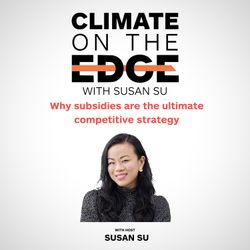Share

Climate on the Edge
Solar Radiation Management's Risks and Opportunities
In this episode I explore the controversial topic of solar geoengineering with Dr. Holly Jean Buck, and Dr. Will Burns, two of the most thorough and interesting thinkers out there when it comes to the topic. Specifically they talk me through the question of “should we ban SRM research”.
There’s a lot these two experts disagree on about SRM, and their back and forth really expanded my thinking on the topic. Together, we break down what SRM is, how it might work, and the different approaches within SRM, such as stratospheric aerosol injection and marine cloud brightening.
This episode provides a nuanced look at SRM as part of the climate action toolkit, I hope it helps you think critically about the role it might play, as it did for me.
Episode Resources
Holly’s Article on SRM research
White House statement on SRM (2023)
Wil’s work on the SRM research ecosystem
Alameda, California Suspends MCB Experiment
Guest-Suggested Articles-
Wil
Clive Hamilton- Geoengineering and the Politics of Science
Holly’s Book After Geoengineering
Holly
Taiwo and Talati- Who are the Engineers?
Wiley Carr- Vulnerable Population’s Perspectives on Climate Engineering
Timestamps
01:26 Urgency of SRM
02:25 Introducing Holly and Will
22:06 State of SRM Research
29:39 Global Players in SRM
43:12 Rules in SRM Governance
46:34 Challenges of Private Sector Involvement
55:22 Conspiracy Theories and Public Perception
01:04:00 Future Prospects
01:07:02 Lightning Round
Leave us a rating and review on Apple Podcasts ⭐️
For more about the show and more information about episodes, visit Climate on the Edge.
Supported by emrgnce - innovative minds exploring climate’s next frontier.
More episodes
View all episodes

Solar Radiation Management to Buy Time for Climate
01:39:21|As a climate investor focused on energy transition and carbon dioxide removal, I've spent years understanding and supporting technologies that drive decarbonization. But lately I've grown concerned that our progress isn't happening fast enough. The urgency of our situation. Which has become very apparent has left me curious about what else is out there.That's why I was so excited to speak with Kelly Wanser, Executive Director of SilverLining. SilverLining is a nonprofit organization dedicated to addressing climate risks through advancing research and equitable governance around solar radiation management. Kelly is an absolute powerhouse here and a true pioneer in this field. Our conversation will get into how SRM might work, where it's at today, what's needed to advance the field and why organizations like SilverLining and its backers believe that it should advance. We'll explore the economic and practical aspects, including concerns about SRM's affordability and the actual, very real logistical challenges of deploying any form of SRM responsibly on a global scale. Kelly is one of the world's most influential figures on SRM and climate intervention beyond emissions reduction. I hope this conversation is as thought-provoking for you as it was for me.Leave us a rating and review on Apple Podcasts ⭐️For more about the show and more information about episodes, visit Climate on the Edge.Follow us on X and Linkedin.Supported by emrgnce - innovative minds exploring climate’s next frontier.
5. What I've Learned So Far & Frontier Climate Headlines
20:53||Ep. 5Fresh from New York Climate Week, I’ve been reflecting on the concept of “toxic positivity” in climate spaces—a term discussed by Amy Westervelt of Drilled. It’s that disconnect between the optimism we often see at conferences and the stark realities of climate disasters unfolding worldwide.On this show, we don’t sugarcoat or shy away from tough questions. Instead, we dive deep into solutions that could truly bend the curve on climate change. We’re not just discussing problems—we’re exploring the complex, messy work required to solve them. In this episode I recap some of the most important lessons I've learned from experts and innovators building climate solutions.I also take a look at some recent climate headlines that you might not have heard about--Vietnam launches a low emissions rice initiative-BlueSky enters a $105 million sales agreement for biochar-based carbon removal, priced at $275 per ton.-China expands its Emissions Trading Scheme (ETS) to include steel, aluminum, and cement, covering 60% of the country’s total emissions.-Chongqing, China, experiments with cloud seeding to combat heatwavesThanks for listening to Climate on the Edge—let’s keep pushing the conversation forward.Episode ResourcesDrilled ArticleVietnam Low-Emissions Rice ProgramBlueSky SaleChina Expands ETS‘Underwear Storm’ in ChinaTimestamps00:00 Introduction to Toxic Positivity at Climate Week01:50 Climate on the Edge so far10:10 Climate Headlines19:25 Upcoming Topics and ConclusionLeave us a rating and review on Apple Podcasts ⭐️For more about the show and more information about episodes, visit Climate on the Edge.Follow us on X and Linkedin.Supported by emrgnce - innovative minds exploring climate’s next frontier.
4. Subsidies are the Ultimate Competitive Strategy
10:38||Ep. 4In this episode of Climate on the Edge, I’m diving into a topic that’s been top of mind lately—what happens if the political winds shift, and we lose momentum on climate policy? With the election approaching, there’s a lot of talk about the potential rollback of the Inflation Reduction Act and what that could mean for climate infrastructure funding. I recently attended Voyagers’ Annual General Meeting, where industry experts discussed the resilience of climate tech companies in the face of political uncertainty, and it got me thinking.One of the most interesting moments at the AGM was Nat Bullard’s presentation, where he highlighted how institutional predictions about renewables have consistently been wrong—renewables continue to grow exponentially. Even with concerns about reduced subsidies, other speakers made a strong case that the best climate companies can thrive on their own. They argued that while subsidies are helpful, they’re not the sole reason for success. So, when is it really safe for investors like us to dive into climate tech?In this episode, I also take a look at the bigger picture when it comes to subsidies. Industries like oil, gas, and agriculture have benefited from billions in government support over the years, and climate tech should be no different. While some fear a shift in political power could direct subsidies back toward fossil fuels, I believe waiting for certainty could mean missing out on huge opportunities. We need to rethink how we view subsidies and invest in the companies building our future, regardless of political changes. Thanks for listening, and as always, I’d love to hear your thoughts!Episode ResourcesNat Bullard’s website w/ links to past presentations: https://www.nathanielbullard.com/Timestamps00:00 The Election…01:03 Insights from the Climate Tech Venture Fund Meeting02:56 The Reality of Subsidies + Wild Statistics09:15 Political Risks and Opportunities AheadLeave us a rating and review on Apple Podcasts ⭐️For more about the show and more information about episodes, visit Climate on the Edge.Follow us on X and Linkedin.Supported by emrgnce - innovative minds exploring climate’s next frontier.
3. Biodiversity and Climate Risk w/ "Nature-Tech" VC Tom Quigley of Superorganism
01:04:43||Ep. 3As biodiversity faces mounting risk from the explosion of H5N1 bird flu and climate change, can investing in nature-focused startups unlock new ways to safeguard our planet’s species and ecosystems?On this episode of Climate on the Edge we’re joined by Tom Quigley, who discusses his unique journey from conservation biology to technology and eventually becoming a venture capitalist focusing on biodiversity. His experiences in field conservation then tech startups shaped his understanding of leveraging technology for conservation challenges. The conversation explores concepts of ecosystem services, biodiversity measurement, land-use change, and the interplay between technology and nature. Quigley emphasizes nature's resilience, existing initiatives for biodiversity protection, and the future of nature tech. He also shares personal reflections from his career working to support nature, and how he hopes to see much more of the finance world join the trend of investing in “nature-tech”. 02:19 From Conservationist to Tech Enthusiast07:51 Challenges and Opportunities in Nature Tech11:41 Understanding Biodiversity and Its Importance18:31 The Economic Value of Ecosystem Services25:47 Complexity of Measuring Biodiversity30:10 Nature as Humanity's Defense Against Climate Disaster32:20 The Role of Mangroves in Storm Protection33:24 Key Drivers of Biodiversity Loss36:49 Understanding Zoonotic Diseases42:12 Hopeful Solutions and Nature's Resilience46:06 The Future of Nature Tech and Biodiversity Investments54:56 Optimism for the FutureEpisode ResourcesSuperorganismTheir blogBook Review on ‘Legibility’Bat Fungus Leads to Population Loss‘Terrifying’ Article on H5N1’s Effect on BiodiversityWWF ReportSharkwater DocumentaryLeave us a rating and review on Apple Podcasts ⭐️For more about the show and more information about episodes, visit Climate on the Edge.Follow us on X and Linkedin.Supported by emrgnce - innovative minds exploring climate’s next frontier.
Humanity's Plan B (And Plan C) w/ XPRIZE Finalist Captura
24:55|This week host Susan Su takes you behind the scenes at the 2024 Carbon Removal Capital Summit, offering exclusive insights from the forefront of CDR innovation.Experience the energy of the event as Susan interviews a broad lineup of industry pioneers from the most exciting carbon removal companies—live, on the conference floor. Learn how these innovators are advancing CDR technologies from pilot projects to full-scale implementation, and discover the bold strategies they’re using to secure funding and scale their breakthrough solutions in the fight against climate change.On this episode Susan and talks with Steve Oldham, CEO of Captura whose ocean-based carbon removal technology uses renewable electricity to extract CO2 directly from seawater.02:29 Understanding Captura's Mechanism03:54 The Shift from Air to Ocean Carbon Capture05:40 Carbon Removal and Geoengineering: Plans B and C11:46 Captura's Success and Innovation14:51 Solutions for Captura’s Energy Needs17:10 Hope and Motivation in Carbon Removal22:40 Future Industry OutlookFollow us on X and Linkedin or visit our website https://climateontheedge.com/
CDR with a Side of Adaptation w/ XPRIZE Finalist Vesta
15:50|This week host Susan Su takes you behind the scenes at the 2024 Carbon Removal Capital Summit, offering exclusive insights from the forefront of CDR innovation.Experience the energy of the event as Susan interviews a broad lineup of industry pioneers from the most exciting carbon removal companies—live, on the conference floor. Learn how these innovators are advancing CDR technologies from pilot projects to full-scale implementation, and discover the bold strategies they’re using to secure funding and scale their breakthrough solutions in the fight against climate change.On this episode Susan and talks with Tom Green, CEO of Vesta, which enhances beaches with olivine, a mineral that removes CO2 from the atmosphere through chemical weathering00:49 Tom Green, CEO of Vesta02:36 Vesta's Recent Projects and Achievements04:10 Solutions in Coastal Protection06:38 Measurement, Reporting, and Verification (MRV)11:12 Regulatory and Future Pathways for Marine CDR14:16 Closing Thoughts and Future OutlookFollow us on X and Linkedin or visit our website https://climateontheedge.com/
Software's Pivotal Role in CDR w/ XPRIZE Finalist UNDO
17:24|This week host Susan Su takes you behind the scenes at the 2024 Carbon Removal Capital Summit, offering exclusive insights from the forefront of CDR innovation.Experience the energy of the event as Susan interviews a broad lineup of industry pioneers from the most exciting carbon removal companies—live, on the conference floor. Learn how these innovators are advancing CDR technologies from pilot projects to full-scale implementation, and discover the bold strategies they’re using to secure funding and scale their breakthrough solutions in the fight against climate change.On this episode Susan and talks with Jim Mann, CEO and Founder of Undo which spreads finely crushed basalt rock onto farmlands, where it enhances soil health and sequesters CO2 through mineral weathering.00:55 Interview with Jim Mann CEO of Undo02:39 Enhanced Rock Weathering Explained04:54 Innovations in Carbon Removal05:40 Logistics and Software in ERW10:47 Scaling Carbon Removal: Financial and Operational Insights15:02 Future of Carbon Removal and Personal ReflectionsLeave us a rating and review on Apple Podcasts ⭐️Follow us on X and Linkedin.For more about the show and more information about episodes, visit Climate on the Edge.Supported by emrgnce - innovative minds exploring climate’s next frontier.
DAC's Dirty Secret w/ XPRIZE Finalist Octavia Carbon
19:56|This week host Susan Su takes you behind the scenes at the 2024 Carbon Removal Capital Summit, offering exclusive insights from the forefront of CDR innovation.Experience the energy of the event as Susan interviews a broad lineup of industry pioneers from the most exciting carbon removal companies—live, on the conference floor. Learn how these innovators are advancing CDR technologies from pilot projects to full-scale implementation, and discover the bold strategies they’re using to secure funding and scale their breakthrough solutions in the fight against climate change.On this episode Susan and talks with Martin Freimuller of Octavia Carbon who design, manufacture, and develop direct air capture technology in Kenya00:56 Martin Freimuller of Octavia Carbon02:28 Why Kenya is Ideal for Direct Air Capture04:50 Operational Challenges and Advantages10:46 The Future of Direct Air Capture17:51 Closing Thoughts and InspirationsLeave us a rating and review on Apple Podcasts ⭐️Follow us on X and Linkedin.For more about the show and more information about episodes, visit Climate on the Edge.Supported by emrgnce - innovative minds exploring climate’s next frontier.